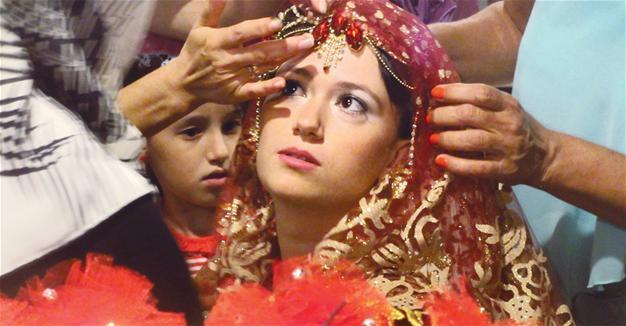Henna Night revised: When tradition meets consumerism
Nazlan Ertan - İzmir
 The bride-to-be sits in the middle, wearing a red Ottoman kaftan. Her friends dance around her with slow and graceful movements, carrying candles and singing together an old, traditional song about a bride’s fear before she leaves her village.
The bride-to-be sits in the middle, wearing a red Ottoman kaftan. Her friends dance around her with slow and graceful movements, carrying candles and singing together an old, traditional song about a bride’s fear before she leaves her village.“Don’t let them ever give away their daughter to faraway lands/ Don’t let them ever look down on the mother’s beloved who left her village behind,” go the lyrics – and then the refrain: “I miss my mother, my father and my village.” There are tears in the eyes of the bride-to-be as her future mother-in-law, equally tearful, approaches her and puts some henna on her hand. Then the older woman puts a gold coin in her new daughter-in-law’s hand – a symbol of the in-laws’ pledge that they are responsible, morally and financially, for the bride from now on.
Then the music, played by a trendy DJ, starts and as the girls – and older women – dance to the Western pop that has dominated the summer of 2016 in Çeşme, one of Turkey’s swankiest holiday resorts. Champagne and wine flows, to be accompanied by a buffet dinner of Aegean delicacies. The evening’s organization is totally eclectic, with American-style “New Mrs” or “Bride-to-be” tags in English and Ottoman-style red head covers on the girls; three different generations of women and a “henna man” drawing complicated tattoos on women’s hands Indian-style.
Welcome to the reinvention of yet another Anatolian custom in the era of consumerism. The traditional pre-wedding Henna Night, which marks a young girl’s entry to womanhood, absorbs the activities of the Anglo-American Hen Night.
The bride, an U.S. educated 25-year-old who is presently working at an international company as a brand manager, opted for a playful mix of the traditional Henna Night and an Aegean beach party. The traditional kaftan is discarded after the henna ceremony - but not before the groom and his friends join the Henna Night in a scene that resembles men joining the Hen Party in the musical “Mamma Mia!”
The bride-to-be has taken the more traditional approach of keeping the Henna Night as a Hen Night; other friends have opted for a mixed one, with both sets of parents and friends of the groom invited. But then, the Henna Nights of the 19th century had not been uniform affairs either – they had shown a lot of local differences across Anatolia. Some took place at the parents’ house two days before the wedding, with the presence of a hodja (religious scholar) while in others, it was combined with a bride’s bath and taken place at a hamam on the morning of the wedding. Then, with the modernization of the republic, Henna Nights were largely forgotten, only to be revived as we approached 2000.
Tradition revived
Shocking as it may be to the Generation Xers, now in their 40s and 50s, their daughters and nieces (members of Generation Y and the Millennials) would not dream of getting married without a Henna Night with “all the trimmings” – the kaftan, the henna, the dance with the candles and a good deal of sobbing before hitting the dance floor for a thoroughly Westernized bachelorette party.
This is precisely what three academics, Guliz Ger, Tuba Ustuner and Douglas B. Holt, called “a playful mixture of the most potent cultural binaries in Turkish history: Religious versus secular and urban versus rural.”
“The traditional Henna Night has served as a rite-of-passage using religious symbolism to reproduce patriarchal relations. The meanings produced at the new Henna Night are quite different, projecting a modern middle class urban sensibility… Although most of the traditional material symbols are present and most of the rules guiding participation are followed, the new urban Henna Night ritual has many subtle differences,” said the paper, titled “Consuming Ritual: Reframing the Turkish Henna-Night Ceremony.”
In other words, some of the rituals are kept, but they are mostly devoid of the traditional symbolism. The rite of henna, for example, is playfully sustained but has lost its traditional meaning – the red paint representing the blood of the virgin bride.
For die-hard anti-Ottomanists, it is the Justice and Development Party (AKP) and its love of the traditional and religious that brought the Henna Night back. Yet, sociologically, the rise of the Henna Nights precedes the rise of the AKP, as the 2000 paper by the three academics shows, and the people who organize the activity are not always traditionalists.
“Henna Night practitioners are proud Kemalists who wear pins in support of secularism, and are scared of the rise of religious fundamentalism. So this is not an easily readable move to reestablish religious or local traditions in the face of globalization,” said the academics.
Others see Henna Night as an off-shoot of the growing wedding industry and the consumer culture around it. The modern wedding is not an event but a process, according to Nagehan Avcı, the editor-in-chief of “Evleniyoruz” bridal magazine. It involves the engagement party, the Henna Night and the morning of the wedding when the groom, accompanied by a drummer, comes to get the bride from his father’s home. “There is an industry around each and every step, with special clothes, entertainment, gifts and guest lists. Nowadays the modern bride often wants it all,” she said.
Even if the bride is indifferent, often her friends would volunteer. My own Henna Night, three years ago, was as unexpected as it was pleasant. My female colleagues at the international retail company where I worked organized a Henna Night with secrecy and efficiency. The evening was complete with lace veils, little boxes of candy and bottles of red nail polish with my name on them. Surprise of surprises, they even found a transgender belly dancer who teased me with sentences like, “Oh, so it is your second marriage – no need for a red belt and henna [symbols that the girl is a virgin] then, huh?”
At the peak of the ceremony, my colleagues forced me into a kaftan, sat me down and danced around me with the traditional song: ““I miss my mother, my father and my village” and suddenly I – professional, cynical, life-hardened me – started sobbing.
Perhaps that is the thing with tradition – no matter how you modernize it, it springs on you and makes you genuinely moved.
















